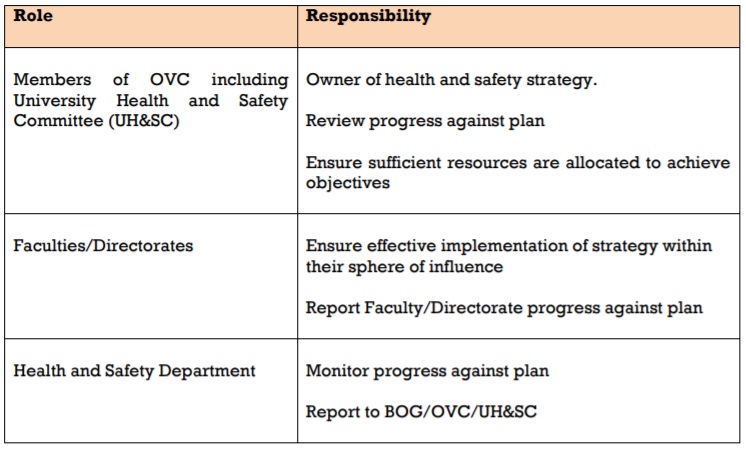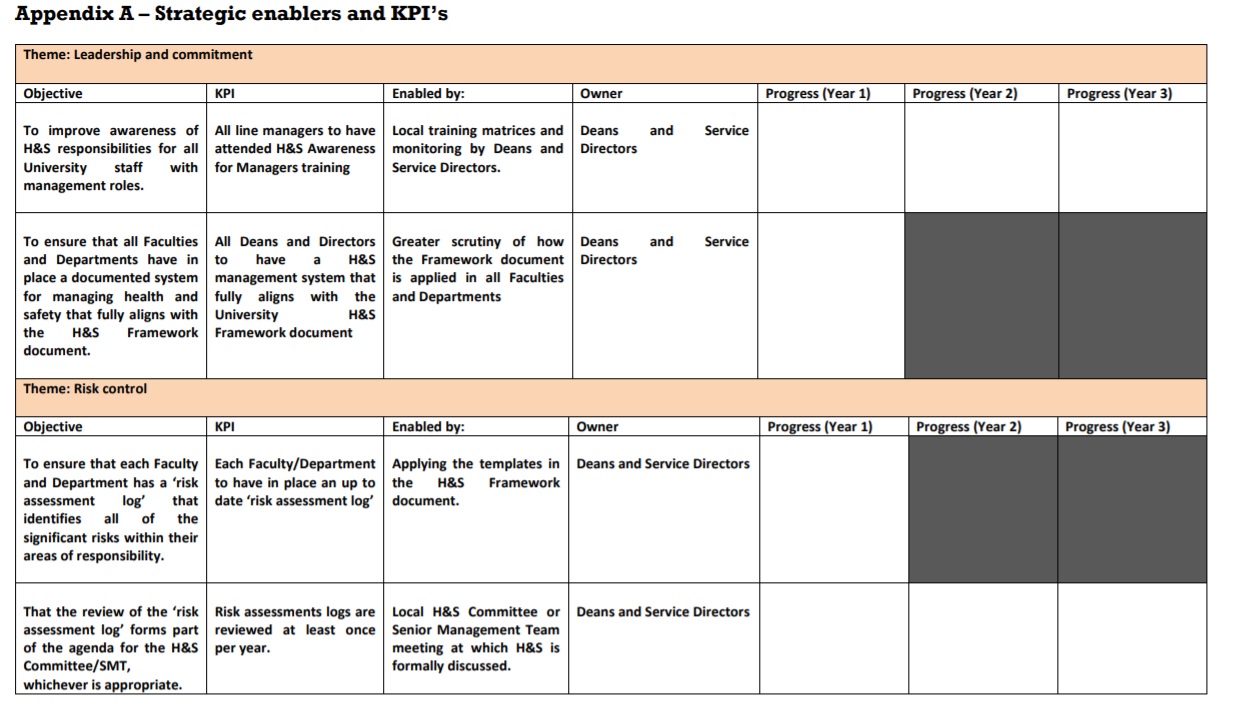This Health and Safety Strategy is driven by our moral, legal, economic and social sense of responsibility and demonstrates that the University values and cares about staff, researchers, students and others who engage with us each day and that we will do our utmost to create a vibrant, teaching and learning community within a safe secure and healthy environment.
The University’s Health and Safety Strategy 2019 to 2022 has been informed by, and has been developed to support, the University of Wolverhampton’s Corporate Strategic Plan 2016-2021, which is built upon the 3 Strategic pillars of:
- Students First
- Skills and Knowledge for Economic and Social Transformation
- Significant Influence and Impact
This plan also attempts to align to our organisational core values (Professionalism, transparency, confidence, collaboration and challenging).
In order to underpin the corporate aim of maximising opportunity through generating knowledge, innovation and enterprise, this strategy has been devised to engage all staff and their representatives to improve the efficiency and effectiveness of our health and safety management system, to deliver a safer and healthier work environment for all those engaging with us, and to encourage and enable a positive, sustainable, safety culture.
The University of Wolverhampton is a leading modern university with a tradition for providing opportunity and academic excellence dating back 150 years and is committed to widening participation in education, offering students from all backgrounds the best learning experience possible and strengthening economies across the globe through knowledge creation and skills development.
The University is committed to protecting the health and safety of all in its community: staff; students; contractors; tenants; partners and visitors.
To be assured that this is happening, the University must ensure the effectiveness of its management systems. This strategy seeks to respond to the changing health and safety climate, enhance existing arrangements and provide further benefits to the strategic and operational management of health and safety at the University.
This strategy has been developed through consultation with key stakeholders, including representatives from Health and Safety Committees, Faculty Registrars, Faculty and Service Department Safety co-ordinators and The Trades Unions, and maps out the strategic direction for health and safety for the next three years, in that it details how the University intends to organise itself in a planned, systematic way to maintain legal compliance as a minimum and promote a positive, sustainable safety culture to continually improve performance.
In order for this strategy to be effective management have certain roles and responsibilities, which are detailed below: 
What is our strategic mission
Our strategic mission is to further enhance an organisational culture committed to positive health and safety, to learn from our experiences and from others’, capitalising on the lessons of successes and failures to improve our performance month-on-month and year on-year. This will include continuing to map onto the university mission, and key pillars, which are based on maximising opportunity (Students first), providing safe learning, research, and engagement opportunities, as well as the current trajectory for growth in respect of student and staff numbers which will relate to new course provisions and strategic initiatives such as University Centres, Academies, UTCs and the Springfield Campus.
What are our strategic Health and Safety Ambitions?
The ambitions of the University Health and Safety strategy are to: Strengthen our collective awareness of health and safety requirements, to apply the benefits of that awareness and to learn and to apply the benefits of that learning, whilst also creating an environment in which continuous health and safety improvement is a significant and growing influence on our work, so that over time it becomes an even more integral and indispensable part of it. In order to achieve the vision, the aim is to further embed our existing health and safety frameworks, improve working relationships both inside and outside the organisation, increasing assurances, competence and consistency across the organisation as well as continuing to map onto the university mission.
What are we?
Positive attributes of the University’s current approach to health and safety management include:
- University Health and Safety Committee which meets twice per annum and is chaired by the Vice Chancellor and provides good governance oversight for the institution;
- Faculty and Departmental responsibility is recognised by Deans and Service Directors who are supported by local ‘safety co-ordinators’.
- A set of corporate health and safety policies and procedures which are regularly reviewed and updated to ensure compliance and conformity with relevant legislation and standards;
- A programme of health and safety audits which has helped to mould a consistent but bespoke set of arrangements for the management of health and safety in the majority of Faculties and Service Departments;
- A well-established health and safety training programme;
- A competent Health and Safety Team which provides sensible and proportionate advice to all Faculties and Service Departments.
Where do we want to be?
Going forwards, our compliance and monitoring regarding health and safety and the broad recognition of the need for good health and safety management systems and the solid foundation of compliance and conformity, means that there is a commitment to continual improvement to ensure our service adapts to the changing requirements of the University, the sector, our staff and students, regulatory requirements as well as always looking to implement and maintain best practice. Continuous improvement is an approach in which all staff seek out, support and implement changes to make the services we provide better quality and more cost-effective.
The potential benefits of continuous improvement are substantial, and all the more valuable at a time when financial budgets are severely constrained. Through making better use of our own and others’ expertise we can make a significant difference to not only health and safety management but also our work’s quality, cost-effectiveness and impact.
The table below (Appendix A) summarises the areas of focus for continual improvement initiatives over the next three years (the life-time of this plan) and the potential for improvement of the current arrangements, which in turn leads to the definition of the plan of work to address them.
Strategic Priorities
In order to achieve the University’s vision for Health and Safety this strategy has been divided into the following strategic priorities, which will be coordinated by the University’s Health and Safety Team. These Strategic Priorities also map onto the key themes of the Universities Safety and Health Association (USHA) Leadership and Management guidance for the Higher Education Sector.
Appendix A: contains the corresponding Implementation Plans and enablers for each Strategic Priority describing the actions to be addressed during the period.
Strategic Priority 1: Leadership and Commitment
Aim
Over the next three years, at all levels of the University starting at Board level, our approach to the management of health and safety will be more proactive than at present, fostered by leaders who clearly understand their roles and responsibilities and accept ownership and full accountability for health and safety matters.
Our aim is to ensure that, in relation to health and safety matters all leaders and managers receive appropriate training to enable them to continue to discharge their legal duties fully, and as a result are able to demonstrate a sufficient level of competence to strategically plan, manage, monitor and continuously improve health and safety performance. This also includes the proposal to embed health and safety as part of the performance development reviews of Senior Management.
Confident leadership of health and safety will confirm to staff and students and others who engage with us that health and safety is a top priority and is a vital component in enriching a positive health and safety culture.
Strategic Priority 3: Training and Competence
Aim
A successful, cost effective health and safety management system requires competent, well trained people at every level of the organisation to ensure that all stakeholders fulfil the health and safety responsibilities expected of them on a consistent basis and play their part in ensuring continual improvement of the health and safety management system. Hence, the University will continue to invest in health and safety training for our staff and where appropriate, will seek more efficient and cost effective methods of delivery. The Health and Safety Team will also look into the feasibility of offering training opportunities to external organisations to help further our collaborative links with industry and business and, where appropriate, contribute to the University’s income targets.
Strategic Priority 4: Performance Management
Aim
Monitoring, measuring and reviewing performance are all vital components in evidencing full legal compliance, by allowing leaders and managers the opportunity to test the robustness and effectiveness of the health and safety management system. Therefore, the Health and Safety Team intend to continue to evaluate the University’s performance against a meaningful set of health and safety key performance indicators set annually and refresh our audit programme in line with the USHA ‘Health and Safety Management Profile (HASMAP)’ guidance document in order to identify continuous improvement.
To make sure we learn from experiences both positive and negative our monitoring activities will be extended and will make greater use of information technology. With a greater degree of accurate, factual information it is expected that leaders and managers will be more empowered to take the necessary action to prevent and correct unsafe behaviours before circumstances escalate.
As there is already a well-established foundation of good health and safety management at the University, shaped by the Health and Safety Framework Document, it is not envisaged that the success of this strategy will be heavily reliant on extensive investment; however, we will need to consider how we best plan, resource, organise, monitor and review our activities to guarantee consistent levels of compliance and conformity across all of our work.
As the University progresses to a more proactive health and safety management approach, we anticipate greater integration between the corporate Health and Safety Team, staff and student representatives, other professional services directorates and academic faculties, better consideration of work activities to eliminate risk.
By engaging the right people, with the necessary level of expertise and competency to actively manage health and safety and to challenge poor practices, we will create a safer, more secure and healthier environment.
Overall responsibility for the delivery of the strategic priorities described in this document necessarily rests with BOG (who are classed as the ‘legal employer’)/CMT/individual OVC members and with the University Secretary who holds delegated responsibility for health and safety matters.
The day-to-day management of this strategy lies with the University Safety Adviser who reports directly to the University Secretary. The implementation of this strategy will be monitored and reviewed on a monthly basis by the University Secretary, twice a year by members of the University Health and Safety Committee and annually by The Board of Governors.
The monthly review will include reporting on progress made against an agreed annual set of Key Performance Indicators (Appendix A).
The intention is that this strategy will be a living document and for that reason will be reviewed and updated each June at the University Health and Safety Committee and also in October as part of the Annual Health and Safety assurance report.




/prod01/wlvacuk/media/departments/digital-content-and-communications/images-18-19/iStock-163641275.jpg)
/prod01/wlvacuk/media/departments/digital-content-and-communications/images-2024/250630-SciFest-1-group-photo-resized-800x450.png)
/prod01/wlvacuk/media/departments/digital-content-and-communications/images-18-19/210818-Iza-and-Mattia-Resized.jpg)
/prod01/wlvacuk/media/departments/digital-content-and-communications/images/Maria-Serria-(teaser-image).jpg)
/prod01/wlvacuk/media/departments/digital-content-and-communications/images-2024/241014-Cyber4ME-Project-Resized.jpg)
/prod01/wlvacuk/media/departments/digital-content-and-communications/images-18-19/210705-bric_LAND_ATTIC_v2_resized.jpg)